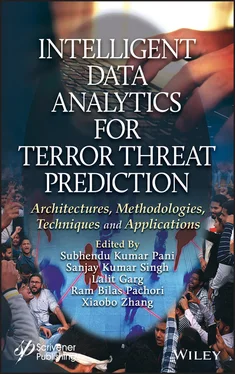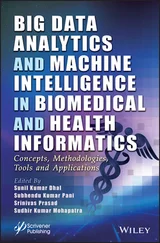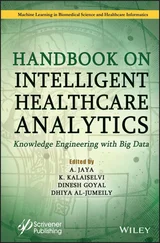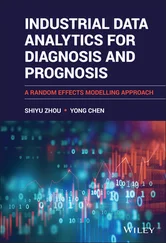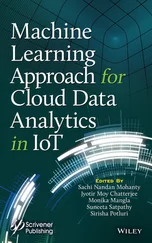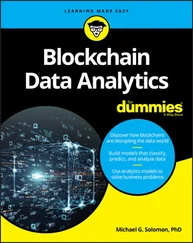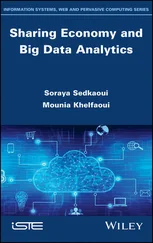Dipalika Das and Maya Nayak present an important discussion and analysis in Chapter 11on the “Crime Pattern Detection Using Data Mining”. The chapter discusses how statistical data related to crime are monitored and analysed by various investigating bodies so that various strategies can be planned to prevent crimes from happening.
In Chapter 12, Nikhil Sharma, Ila Kaushik, Vikash Kumar Agarwal, Bharat Bhushan, and Aditya Khamparia present the role of “Attacks & Security Measures in Wireless Sensor Network”. The chapter presents different layer attacks along with security mechanisms to avoid the effect of attack in the network. Security is considered as one of the main constraints in any type of network so it becomes very important to take into consideration the key elements of security which are availability, integrity and confidentiality.
Hemanta Kumar Bhuyan presents an important discussion and analysis in Chapter 13on the role of “Large Sensing Data Flows Using Cryptic Techniques”. The chapter discusses the replicated crimes using cyberspace by criminals.
In Chapter 14, Chandra Sekhar Biswal and Subhendu Kumar Pani present the role of “Cyber-Crime Methodology and its Prevention Techniques”. The chapter places the emphasis on various frauds and cyber-crime happening in India, as well as the different types of cyber-crimes along with the probable solutions for that.
Dr. Subhendu Kumar Pani
Department of Computer Science & Engineering, Orissa Engineering College, BPUT, Odisha, India
Dr. Sanjay Kumar Singh
Department of Computer Science and Engineering, Indian Institute of Technology Campus, BHU, Varanasi, Indore, India
Dr. Lalit Garg
Department of Computer Information Systems at University of Malta, Msida
Dr. Ram Bilas Pachori
Department of Electrical Engineering, Indian Institute of Technology Campus, Indore, India
Dr. Xiaobo Zhang
School of Automation, Guangdong University of Technology, China
November 2020
1
Rumor Detection and Tracing its Source to Prevent Cyber-Crimes on Social Media
Ravi Kishore Devarapalli* and Anupam Biswas†
Department of Computer Science Engineering, National Institute of Technology Silchar, Assam, India
Abstract
Social media like Facebook, Twitter, WhatsApp, Sina Wiebo, Hike, etc. play an important role in the information spreading in today’s world. Due to large scale connectivity, some of the cyber criminals are choosing these platforms to implement their criminal activities such as rumor spreading which is popularly known as rumor diffusion. In a pluralistic society like India, rumors that spread over various social networking platforms are much more vulnerable. It is challenging for even public, government and technical experts working on social media to find these cyber-crimes and its origin to punish the culprit. Nowadays, some cyber criminals are choosing different platforms and paths to accomplish their plans to escape brilliantly from those activities. Thus automated detection of rumor and tracing its source has great importance.
This chapter surveys the different automated rumor detection systems in social networks and techniques to trace the source of rumor. Detection of rumors on social networking platforms is possible through analysis of shared posts and comments wrote by followers. After detection of rumors, next job is to 1) prevent the rumors from further spreading and 2) identification of culprit i.e. the originator of rumor. This chapter covers both these aspects. The opinion of an influential person in the group influences others very easily. Cyber criminals may use separate communities in social media to fulfil their activities. Thus, it is important to trace the most influential person in community to prevent further spreading. This chapter aims to discuss the recent techniques that are developed for identifying influential persons in the group. The chapter also aims to study the various techniques developed for identifying the culprit, which are based on factors like network structure, diffusion models, centrality measures, etc. The chapter will also discuss the various challenges including real-life implementation, evaluation, and datasets in respect to both rumor detection and rumor source tracing.
Keywords: Rumor, rumor source detection, centrality measures, social networks, diffusion models
Social media like Facebook, Twitter, Sina Wiebo, YouTube and WhatsApp are becoming major online businesses. Social media uses computer-based technology with internet to ease the sharing of ideas, thoughts, and information by building of virtual networks and communities [1]. Nowadays, social media plays an important role for information diffusion [2]. Social networking sites like Facebook, Twitter, and WhatsApp have become popular over a short period of time with their user-friendly features [3]. It has advantages as well as disadvantages too [4]. Advantages of Information diffusion are, enable users to upload and share photos, videos, comment and like them, without hurting any communities, religions, or political parties, etc. The other side where people may share abusive photos, videos, terror activities or sensitive information about country, which are criminal activities come under cyber-crime.
Cyber-crime is a criminal activity which involves a computer and internet as part of it [5]. There are many activities that fall under cyber-crime such as passing rumors, online harassment, hacking emails, websites or databases, etc. [6]. To detect whether given data is rumor or fact, use text classification algorithms like Naïve Bayes theorem and support vector machine [7]. These classical algorithms are mainly used for classification purpose, and classify text data based on features and dimensions [8].
Detection of these cyber-crimes and finding the culprit involved becomes challenging for public, government and police departments as it is very difficult to detect and even hard to prove. As technology progresses, people can remotely access networked computer devices from different locations. Detection of Rumor Source in social media is also difficult as people can use various devices, IP addresses and emails to bully online, such as posting offensive images, videos or any rumors about others. So detection of these cyber-crimes and origin of those as early as possible in social networks will be helpful to combat the further diffusion and also punish the culprit involved [9]. After detection of rumors in social network it is required to combat them by finding people who spread first and punish them. Rumor source identification in social networks become very difficult as discussed earlier many techniques have been introduced, but very few become popular in finding origin of rumor.
Before going to find rumor source, there is a need of considering factors such as diffusion models, network structure, evaluation metrics and centrality measures [10]. Topology associates with Network structure is in tree or graph, and observation of network example complete observation, snapshot observation, and monitor observation, etc. [11]. If network topology is tree or graph use maximum likelihood (ML) estimator to estimate source [9]. Next factor consider diffusion models to get how fast information diffusing over network [10]. There are four diffusion models namely Susceptible-Infected-Susceptible (SIS), Susceptible-Infected (SI), Susceptible-Infected-Recoverable-Susceptible (SIRS) and Susceptible-Infected-Recoverable (SIR). SI model considers each node in any one of two states susceptible or infected [12]. SIS model considers three states susceptible-infected-susceptible, where infected node can again susceptible in future [13, 14]. SIR model also has three states but susceptible-infected-recovered, where infected node can be recovered by having immune power or taking medicines [15]. SIRS has four states of nodes such as susceptible-infected-recovered-susceptible, where recovered node may be susceptible in future [16]. Another factor consider in source detection is centrality measures [17]. There are several centrality measures such as degree centrality, closeness centrality, and betweenness centrality are popularly considered. All these factors considered to detect source in network are explained in following section.
Читать дальше
